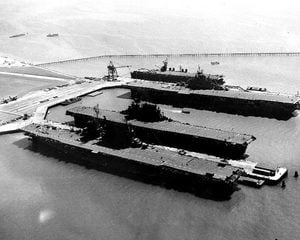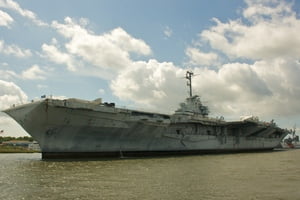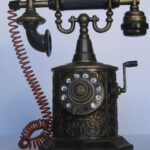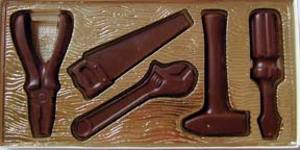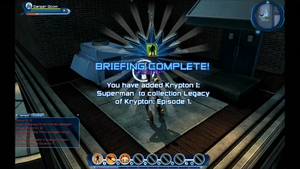America entered World War II on December 8, 1941 at a serious naval disadvantage. The Japanese strike at Pearl Harbor had left the U.S. Pacific Fleet crippled and the Japanese in virtual control of the seas. The surprise attack also marked the rise of the aircraft carrier as the chief weapon of naval warfare on both sides. For the Japanese, the simple necessity of conducting aerial warfare over the expansive Pacific dictated their strategic reliance on the aircraft carrier. For the U.S., it was another necessity altogether.
By the evening of December 7, the U.S. Navy was faced with all eight of its battleships, the backbone of its fleet, sunk or out of commission. The Imperial Japanese Navy, however, had failed to neutralize its secondary targets, the American fleet carriers Enterprise, Lexington, and Saratoga, none of which were at port in Pearl Harbor when the Japanese struck. While at a numerical disadvantage, America retained the capability to project air power over the Pacific. This would prove critical in the early naval clashes of the war at Coral Sea and Midway, and it transitioned the U.S. Navy into a battle fleet built around carrier task forces.
Their power also made them a prime target. By 1943, the Japanese had lost six carriers in action, four of them in the strategic disaster at Midway. The tally wasn’t much better on the American side, which had begun the war with seven carriers and lost four of them. With the addition of the capital Essex class, however, the aircraft carrier became sturdier and deadlier. Not one Essex class ship was lost in action during World War II. In fact, the Essex carriers were so durable that more than half of them were decommissioned after 1970. The last to be decommissioned was the Lexington (CV-16) in 1991, nearly 50 years after she’d been launched.
The great aircraft carriers of World War II, as with most retired vessels, largely met their fates at the scrapyard. Even the mighty Enterprise, the most decorated ship of the war, couldn’t escape destruction. Today, only five carriers currently remain as museum ships docked in the U.S. They are enduring monuments to American sea power.
U.S.S. Hornet (CV-12)—Essex class aircraft carrier, located at the U.S.S. Hornet Museum in Alameda, CA since October of 1998. The Hornet (first designated the Kearsarge) was named after the carrier lost at the Battle of the Santa Cruz Islands (CV-8), which had launched Jimmy Doolittle’s daring air raid on Tokyo. She was commissioned in November of 1943 and earned seven battle stars and the Presidential Unit Citation for her service in World War II. Hornet was also the recovery ship for the crews of the Apollo 11 and 12 moon missions.
Website: http://www.uss-hornet.org
U.S.S. Intrepid (CV-11)—Essex class aircraft carrier, located at the Intrepid Sea, Air, & Space Museum in New York City, NY since August of 1982. She was commissioned in August of 1943 and received five battle stars for her service in World War II. Following the war, she served as a recovery vessel for the Mercury and Gemini space programs and saw action in Vietnam before being decommissioned in 1974. Intrepid was also the first American carrier to launch aircraft via steam catapults.
Website: http://www.intrepidmuseum.org
U.S.S. Lexington (CV-16)—Essex class aircraft carrier, located at the U.S.S. Lexington Museum On The Bay in Corpus Christi, TX since June of 1992. The Lexington (first designated the Cabot) was named after the carrier lost at the Battle of the Coral Sea (CV-2). She was commissioned in February of 1943 and earned 11 battle stars and the Presidential Unit Citation for her service in World War II. Lexington operated as a training carrier from 1969 until her decommissioning in 1991, the last Essex class carrier in service.
Website: http://www.usslexington.com
U.S.S. Midway (CV-41)—Midway class aircraft carrier, located at the Maritime Museum of San Diego in San Diego, CA since June of 2004. She was the first postwar carrier to be commissioned, and is the only non-Essex class carrier of the era to be preserved. Although she entered service too late to participate in World War II, she was the longest actively serving aircraft carrier in American naval history, with a 47-year tour of duty that included service in 1991 as a flagship during Operation Desert Storm.
Website: http://www.midway.org
U.S.S. Yorktown (CV-10)—Essex class aircraft carrier, located at Patriots Point Naval and Maritime Museum in Mount Pleasant, SC since June of 1975. The Yorktown (first designated the Bon Homme Richard) was named after the carrier lost at the Battle of Midway (CV-5). She was commissioned in January of 1943 and earned 11 battle stars and the Presidential Unit Citation for her service in World War II. She later earned five battle stars for Vietnam service.
Website: http://www.patriotspoint.org.
Sources: Naval Historical Center, Navy.mil, Wikipedia
